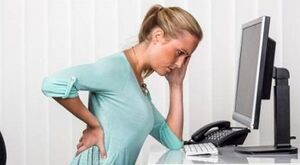
Discomfort in any part of the spine restricts mobility, reduces performance and significantly affects the quality of life. Back pain can have a variety of causes that are not always related to bone and joint structures. To determine the factors that are causing the problem, you need to see a doctor.
Types of back pain
There are two ways this syndrome occurs. In the first case, back pain is caused by pathologies of the musculoskeletal system. It includes bone, joint and muscle tissues, ligaments and tendons. The second likely reason that causes severe back pain on the right or left side is lesions of the internal organs. Inflammatory processes are often accompanied by compression of the nerve roots, which provokes the problem under consideration.
Back pain in diseases of the spine
An obvious factor causing discomfort is damage to the musculoskeletal system. If the back hurts between the shoulder blades, neck, or lower back, it is important to be aware of the intensity, duration, and type of symptom.
In diseases of the spine, nearby muscles, joints and ligaments, the pain has the following characteristics:
- Strong- Complaints are difficult to bear without analgesics or anti-inflammatory drugs. The sensations are very pronounced, restrict mobility and flexibility.
- Paroxysmal- occurs in a certain position of the body or during certain movements. It is extremely rare for the back to be in constant pain.
- Sharp- sharp, piercing, shooting. Emotions are similar to sudden mechanical damage.
Back pain with diseases of the internal organs
Swelling, inflammation and suppuration lead to an increase in the volume of soft tissue. This causes compression of nearby nerve roots and ends, causing pain under the left or right shoulder blade, neck, lower back, or tailbone. The presented symptom is less pronounced in comparison with pathologies of the musculoskeletal system. Even if the whole back hurts, the discomfort is bearable. They are long lasting, sometimes permanent.
Pain can be specific:
- hurts;
- pull; press
- ;
- is stupid.
Why does your back hurt?

Now that you have studied the characteristics and severity of the specified characteristic, it is important to determine its location. It must be understood that the exact causes of back pain cannot be determined by yourself. A thorough medical examination, laboratory and instrument tests are required for a correct diagnosis. For example, pain under the right shoulder blade can cause both osteochondrosis and lung damage on that side of the body. Because of the multifactorial nature of the problem described, it is dangerous to self-medicate.
The back hurts over the shoulder blades
Discomfort, stiffness and poor mobility in the shoulder girdle and neck are characteristic of osteochondrosis. Depending on the position of the strangled nerve root, back pain can occur on the left or right.
In addition to osteochondrosis, a pathological symptom occurs for the following reasons:
- stretching;
- muscle overload;
- osteoarthritis;
- fibromyalgia;
- ankylosing spondylitis;
- stenosis of the spine;
- myofascial syndrome;
- rheumatoid and psoriatic arthritis;
- polymyalgia;
- intervertebral hernia;
- neck injuries;
- osteomyelitis;
- tuberculosis;
- acute thyroiditis;
- neoplasms of any quality, their metastases;
- mechanical damage to the spine;
- diseases of the internal organs (kidneys, brain, heart, intestines, esophagus and others);
- lymphadenitis;
- shingles;
- meningitis.
Back pain in the shoulder blades
The central part of the spine is the most common localization of stabbing, pulling and cutting sensations. In this case, it is important to clarify on which side the discomfort is felt.
Pain under the right shoulder blade from back to back can occur for the following reasons:
- biliary colic;
- subphrenic abscess;
- disorders of kidney function;
- cholecystitis;
- tuberculosis.
If the back hurts in the area of the left shoulder blade, the following pathologies are suspected:
- mental problems;
- ulcerative gastritis;
- Diseases of the esophagus;
- myocardial infarction;
- inflammation of the pancreas;
- renal colic.
Back pain in the middle of the shoulder blades often indicates diseases of the musculoskeletal system:
- herniated disc;
- osteochondrosis;
- shoulder blade injury;
- curvature of the spine;
- spondyloarthrosis;
- intercostal neuralgia;
- pterygoid shoulder blade;
- washer projection;
- muscle spasm;
- humeral-scapular polyarthrosis;
- tumor, osteomyelitis of the shoulder blade.

Less often there is pain in the middle of the back with pathologies of the internal organs:
- hepatitis;
- respiratory diseases of the lungs;
- cholecystitis;
- biliary dyskinesia;
- duodenal ulcer;
- ischemic heart disease;
- angina pectoris.
Back pain in the lumbar region
The part of the spine shown has the maximum load, so that it can be easily damaged. Severe back pain occurs mainly after intense exercise or physical exertion. It gradually disappears by itself in the process of calm.
Back pain in the lumbar region can have the following reasons:
- cracks and deformations of intervertebral discs;
- fracture of one or more vertebrae;
- inflammation of the joint capsules;
- osteochondrosis;
- fibrositis;
- rupture of the vertebral ligaments;
- compression of nerve endings;
- osteoporosis;
- sacral radiculitis;
- scoliosis;
- lordosis;
- arthritis and osteoarthritis;
- spinal tumors;
- diseases of the genitourinary system;
- intestinal and kidney pathology;
- Reiter syndrome;
- epidural abscess;
- brucellosis of the intervertebral disc;
- start of the menstrual cycle;
- pancreatitis;
- urolithiasis;
- pyelonephritis;
- cystitis and others.
Pain in the lower back below the waist
Complaints in the coccyx area rarely occur in isolation; they are accompanied by complaints in the adjacent parts of the spine.
Lower back pain occurs for the following reasons:
- tailbone fracture;
- scoliosis;
- sprain of ligaments, muscles;
- osteoarthritis;
- lead;
- hernia;
- lordosis;
- osteochondrosis;
- ankylosing spondylitis;
- radiculitis;
- intestinal obstruction;
- inflammation of the appendix;
- kidney pathology;
- chronic constipation;
- gastritis;
- pyelonephritis;
- hepatitis;
- cystitis;
- pregnancy;
- menstruation;
- climax;
- urolithiasis;
- ovarian cyst;
- uterine fibroids;
- inflammation of the limbs;
- endometriosis and others.
What to do if your back hurts?
First of all, it is important to understand that it is not possible to independently determine the true cause of the discomfort. Diagnosing and treating back pain is the prerogative of a qualified specialist. Before you see your doctor, you can use anti-inflammatory nonsteroidal drugs or analgesics to relieve symptoms. Full therapy is carried out by an experienced doctor.
Which doctor should I go to if my back hurts?

The first specialist recommended by the reception is a therapist. He can guess why his back is sore and refer him to a specialist. Depending on the reasons, doctors from the departments of the musculoskeletal system or internal organs are included in the therapy.
The following specialists treat severe back pain:
- vertebrate;
- neuropathologist (neurologist);
- urologist;
- nephrologist;
- podiatrist;
- gynecologist;
- endocrinologist;
- cardiologist;
- gastroenterologist.
Ointment for back pain
Topical medications do not eliminate the triggering factors, but rather temporarily relieve discomfort and help endure effective treatment.
If the muscles of the back hurt, it is better to use local irritant drugs with a warming effect.
For lesions of bones, joints and ligaments, an anti-inflammatory ointment is recommended for pain in the lower back, back or neck.
Injections for back pain and back pain
A pronounced symptom impairs normal life activity and basic self-service in everyday life. To relieve intense or excruciating sensations, you will need an intramuscular pain reliever for back pain. Nonsteroidal analgesics reduce inflammation and block the sensitivity of nerve receptors so they can provide rapid relief.
Exercises against back pain
Active physical activity in the acute phase of a pathology is strictly prohibited. Pain under the shoulder blade caused by heart disease can not only be exacerbated by exercise, but also made more difficult by a heart attack. It is important to coordinate all activities with your doctor or do them during the recovery period.
Exercises for the upper back and neck (repetitions 3-5 times):
- counter pressure.Close your hands in a "lock" at the back of your head. Squeeze them and try to lower your head forward. Resist the neck muscles with a delay of 5-7 seconds.
- Forward pressure.Place your palms on your forehead. Squeeze them and try to throw your head back. Resist your neck and linger for 5-7 seconds.
- Page print.Press the left and right of the head alternately with the palms of the hands. Resist by putting weight on the neck, similar to the previous points.
- circular movements.Lower your chin on your chest. Slowly turn your head left to right and back as if rubbing your collarbones.
- rotates.Look one way and then the other, and stay in each position for 5 seconds.
Exercises when the back hurts in the shoulder blade area (repetitions 5-10 times):
- Press.Lie on your back, close your hands behind your head, bend your legs at the knees. Take a deep breath. As you exhale, simultaneously straighten your elbows and knees to your stomach so that they touch.
- Climbers go.Stand on all fours and move around the room according to the "left hand, right leg" principle. Continue for 10-20 minutes.
- buttock bridge.Lie on your back, bend your knees, stretch your arms over your body. Lift the pelvis up and down.
- stretch.Stand with your legs wider than your shoulders. Alternately stretch your chest to your right and left knees without arching your back.
- wrinkles.In the position from the previous point, lower your head as much as possible with your back straight.
Exercise against back pain (10-15 repetitions):
- embryo.Lie down and bend your knees. Pull them to your chest with your hands and stay for 10 seconds.
- Cat.Stand on all fours with your hands on the floor and bend your back down.
- camel.Bend the spine upwards in a similar position.
- rotation.Starting position - as in the first exercise. Rotate your pelvis and legs left and right without lifting your lower back off the floor.
- hunting dog.Get on all fours. Extend your right arm forward and straighten your left leg, holding it for 5 seconds. Repeat for the other side.






























